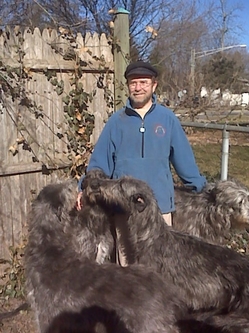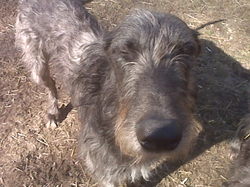The Scottish Deerhound is a rare breed, but a Ypsilanti man strives to keep it vibrant

Lorrie Shaw | Contributor
In watching this years' Westminster show, the average viewer might not have realized the history that was about to be made. But, a select group of people who were already familiar with Scottish Deerhounds were undoubtedly glued to the television while they waited with baited breath, as they watched as Ch. Foxcliffe Hickory Wind — better known as Hickory — take the coveted Best in Show accolade.
It was a first for the breed, which is a vigorous but uncommon one.
Recently, I had the pleasure of meeting up with Bradley Nelson and his four Scottish Deerhounds at their home in Ypsilanti and got a firsthand look as to why these dogs are so special.
The first thing that you notice is their physical appearance, of course: These graceful creatures are tall and have the kindest, soft-looking eyes that I've ever seen on a canine.
Romping around in their backyard, I found these dogs to be gentle giants who have a penchant for play, close human companionship and cool weather and who have vastly different personalties. As a rule, though, they're quiet dogs, always ready for a good scratch behind the ears, and yes, they do love to run.
In my Q & A with Nelson, he muses about how he was drawn to these dogs and how he's become a curator of sorts in this region of this little-known breed that was once owned only by royalty and hence the name, used to hunt deer. Now sharing his life with four Scottish Deerhounds, two males and two females — Kes, a jubilant girl who is just a year old, the effervescent Balor who is 3, Jane, who is 5, the ever-calm elder female and mother of Kes, and last but not least the very laid back Istari, who is 8 and father of Jane.
What drew you to Scottish Deerhounds, and how did you start on your journey with them?
I always loved dogs, and after college, I was ready for one of my own — a big one. I did a lot of research, and discovered Scottish Deerhounds.
I located a breeder and went to meet with them to get a feel for the breed firsthand. The dogs knocked my socks off with their demeanor. They have such great qualities. In fact, Sir Walter Scott described them as "the most perfect creature of Heaven."
Even then it was difficult for people to acquire these dogs; the breed is carefully curated, and there aren't a lot of the dogs around. Prospective owners are vetted carefully!
What ended up happening was a young dog, Deena, was brought back to the breeder by her owner. She was a great dog. I rescued her and kept in contact with the breeder. They were impressed with my diligence in caring for Deena, and we built a rapport. That's how I established myself as a owner worthy of having a Scottish Deerhound. I adopted another one later, Donner, a male.
I got involved with deerhound groups and clubs, and things progressed from there.

Lorrie Shaw / Contributor
It's obvious by looking at them, that these dogs by nature, are meant to run — to hunt. How does one indulge this breeds' instinctive drives?
Yes, they are meant to run. They really do need a fenced-in yard where they can run and roam freely. Being cooped up in a house all day and just going out for a daily leashed walk isn't a good life for them.
As far as activities go, Scottish Deerhounds are sighthounds — they've been bred for hunting. So, we need to give these dogs a way to satisfy their drives. One of the things that one can engage their dogs in, is lure coursing — which was developed in the 1970s. It's an enjoyable activity and it's a great way to interact with other sighthound owners. In fact, I'll be attending an event in just a couple of weeks in Manchester to certify the youngest of my dogs, Kes.
You mentioned the camaraderie and culture associated with other Deerhound owners. Do you do other activities besides lure coursing? What other areas are you all cooperative in?
I really enjoy the dog shows. Meeting up with fellow breed owners is great; we always have a lot to catch up on and seeing their dogs is a big part of it.
It's important to stay connected to fellow breeders, too. The gene pool is rather small where Scottish Deerhounds are concerned, and the problems that have occurred in more well-known breeds — like over breeding — aren't an issue for this breed. That's because we collectively strive to keep the bloodlines healthy and have good communication. My kennel name is CuNevé, meaning "celestial hound".
They are beautiful dogs, certainly — and large! How big do they get, typically? And, is their size a problem where being indoors is concerned?
They are beautiful. They come in shades of gray and have a rough coat. 28 inches is the minimum height for females, and males average at about 31 and 5/8 inches. Istari's coat has lightened a bit with age, but he still looks great.
Despite their size, they are good when they're in the house — they're more rambunctious outside. There was a raccoon outside here last night. and they are still very interested in knowing where it is. (The dogs are at this point, totally ignoring me and eagerly sniffing around the fence and a tree, evidently where the raccoon was hanging out.)
They are hunters. If there was a small animal, like a cat, squirrel or otherwise around, they would definitely run after it. It's their nature.
***
It's clear that Nelson has not only a vast knowledge about these dogs, but in sharing day-to-day life with them, he is clear on each of his dogs' personalities. Completely devoid of the sense of rigidity that is present in some pure-breed afficianidos, he honors their respective physical attributes and personalities. He's a thoughtful owner, speaking kindly to each of them, and they respond in kind with their restful spirit.
Lorrie Shaw is lead pets blogger for AnnArbor.com and frequently writes about dogs. She welcomes your contact via email, and to follow her daily adventures as owner of Professional Pet Sitting on Twitter.


Comments
John Spieser
Wed, Apr 6, 2011 : 6:19 p.m.
Nice profile Lorrie ! And cheers to Bradley Nelson for his concern of the long-term health of the breed ! I do love those dogs.